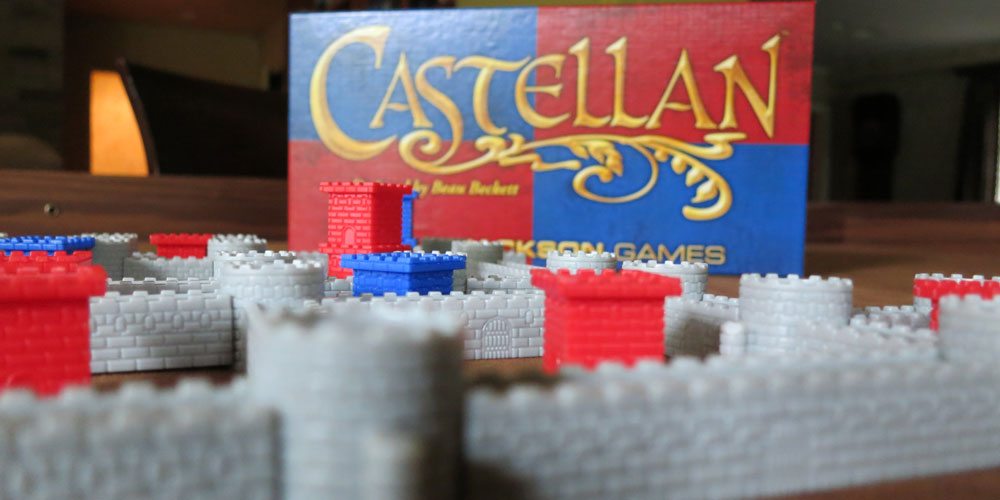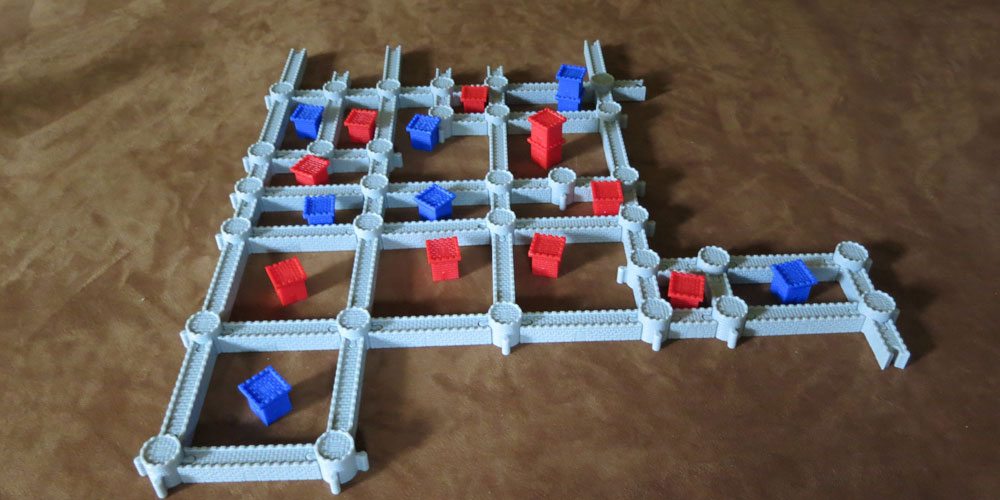“The King has decreed a new castle, and sent his most trusted nobles to supervise its construction. After the last stone is laid, a single lord will be chosen as the ruler of the castle. The one who uses his resources most wisely will become … the Castellan!”
If you like building and you like castles, then Steve Jackson Games has a game for you. Castellan, new and out this month, is a two-player game (or potentially for 3 or 4 — see below) where each competes to close courtyards and claim them with a keep. It’s like a game of Dots and Boxes, but with a twist — points are scored by counting the number of towers in an enclosure. Sounds good, but is it? Let’s begin building and find out!
Components
There is a lot of plastic in the box. There are 10 colored keeps for each player, each serving as a marker for claiming a courtyard. The castle is built with 88 pieces of gray brickwork — 26 long walls, 30 short walls, and 32 towers. The towers all have four pegs on them and each end of the walls have a matching hole ends, with the pieces connecting like puzzle pieces.
Additionally, each color gets fourteen cards, identical to the opponent’s. These cards dictate the combination of walls and towers that can be used to build when the card is played. Each set is broken into two classes, towers and walls, and there are seven of each. On the wall cards, there may be towers and on the towers, there may be walls, but it’s no guarantee. There are also some cards that allow the player to draw an extra card during the draw phase.

Like all Steve Jackson games, the quality is top-notch and the pieces have a bit of a LEGO quality to them — you can’t help but want to start building!
Gameplay
After setting up the game by distributing color-coded cards and keeps, the cards are divided into tower and wall cards and quickly shuffled. Each player takes two cards from each deck and reviews building possibilities. On each turn, a player may play as many cards as he wants, but will only be able to rearm his hand with a single card at the end of the turn. (Some cards allow an additional card during the draw phase.)
A player then lays down the chosen cards to play during the round and takes the towers and walls from the inventory. All pieces must be played during the turn, none can be saved for later. If a piece cannot by played for any reason, it is passed to the other player for use during her turn. All pieces must connect to existing pieces; you can’t start another castle.
When a courtyard is created by enclosing an area, it can be claimed. This is done by placing a keep of the player’s color in that area. When a player claims a courtyard, she gets points for each tower that touches her courtyard. The first courtyard claimed by each player can be marked with a double keep — one stacked on another — that will score double points at the end of the game.
Once a player has built with his castle pieces and claimed any completed courtyards by placing keeps, his played cards are discarded and he draws a single card to his hand. Play continues until one player plays his final card. The other player is given an opportunity to play and then the game ends. Towers are tallied and the highest score wins.
Conclusions
While the game seems simple, there is a good bit of strategy involved. If you play most or all of your cards at once in a “super-build” turn, you will be left with few choices for the rest of the game. Once you claim a courtyard, you can continue to build inside it, dividing it and earning more points and gaining an advantage on your opponent. Inside courtyards, walls and towers can be added like peninsulas, boosting points earned. It’s also very important to try to take a balanced approach to cards you use. It’s possible to be stuck with nothing but wall cards at the end of the game, which may leave you with no options for closing courtyards and scoring points.
Although the game is only for two players, you can play with up to four players by purchasing a set with a separate color scheme. (Boxes are very clearly either red/blue or yellow/green.) Red and blue boxes are English only, but the yellow and green boxes have instructions in five languages. With four players, you could end up with huge castles! Reportedly, the initial release of Castellan is red/blue only. The yellow/green sets will follow in a month’s time.
Additionally, I love the way the pieces lock together. Players, on their turn, can actually grab the castle and rotate it to gain another perspective. What’s more, should someone bump your game table, you have nothing to worry about — all the pieces stay together, all the time.
The game is recommended for players 10 and older, but those as young as 6 or 7 should likely be able to have fun with Castellan. The back of the box says that games should take about 30-45 minutes to play. While I can see a slow, tactical game lasting that long, we built out entire castles in 15 minutes, or less, a few times.
Castellan is a game I’ve had on my radar for quite some time, especially after playing a prototype at PAX Prime last year. The rules are straight-forward and easy to understand, plus, it’s simple enough for young kids to get. However, there’s enough strategy for experienced gamers to have pretty competitive, tactical games. I really enjoyed playing this – both with my kids and with other, more experienced players. It’s a lot of fun and a game that is great for the whole family to play.
Disclosure: GeekDad received a copy of this game.







One minor correction, Dave: you don’t have to claim the FIRST enclosure for double points. You can double any keep as you claim an enclosure, but you can only do it once.